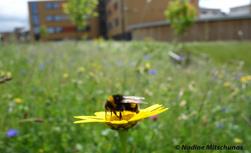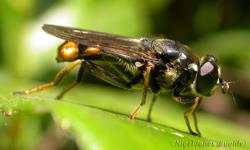Introduction
Pollinators are an essential component of the Welsh environment. Honeybees and wild pollinators including bumblebees, solitary bees, parasitic wasps, hoverflies, butterflies and moths and some beetles are important pollinators across a wide range of crops and wild flowers and help improve the productivity of pasture systems for livestock grazing. Twenty percent of the UK cropped area contains crops which are dependent on pollinators and the value of pollinators to UK agriculture is over £690 million per year. The value of honey produced in Wales is also considerable with a wholesale value in excess of £2 million in 2011. In 2017, they were 3,366 beekeepers registered in Wales.
There has been growing concern regarding the population status of insect pollinators, and in turn the pollination service they provide. As with most other areas of biodiversity, the main threats to pollinators include habitat loss, environmental pollution, climate change and the spread of alien species.
Action Plan for Pollinators in Wales
The Welsh Government has worked with industry and stakeholders to look in more detail at the evidence and issues around pollinators and their conservation in Wales. Following consultation, in 2013, an ' Action Plan for Pollinators in Wales' was launched setting the strategic vision, outcomes and areas for action to halt and reverse pollinator decline in Wales. A Pollinator Task Force comprising of key stakeholders is now active.
In 2018, the Action Plan for Pollinators in Wales was updated by members of the Pollinator Task Force. The overall aim of the APP remains relevant however a review to update the actions was needed to reflect; the Bee Friendly initiative, the UK National Pollinator Monitoring Scheme, bee health policy which takes into account the risks from an Asian Hornet outbreak, the ongoing and new work by APP Task Force members and new requirements arising from the Well-being of Future Generations (Wales) Act 2015 and the Environment (Wales) Act 2016.
Action Plan for Pollinators Review 2013-18 and Future Actions
Bee Friendly
Bee Friendly is an initiative aimed at communities and community organisations, schools, public bodies, town and community councils, businesses, universities and colleges, places of worship…….. and many other organisations, all around Wales.
We think it is the first co-ordinated national scheme of its kind and has at its heart – making Wales a Pollinator- Friendly country.
Although the scheme is called Bee Friendly, we want people to take action to help all our pollinators, and not just bees.
An update on progress of the Action Plan for Pollinators has been compiled by the taskforce in a series of downloadable info graphics.
Other Pollinator Work
UK Pollinator Monitoring Scheme
UK Pollinator Monitoring Scheme (PoMS) has been established two new large-scale surveys. To find out how you can take part and help us track changes in pollinator numbers please visit: https://www.ceh.ac.uk/our-science/projects/pollina...
PoMS is the only scheme in the world generating systematic data on the abundance of bees, hoverflies and other flower-visiting insects at a national scale (currently across Wales, England, and Scotland). Together with long-term occurrence records collated by the Bees, Wasps and Ants Recording Society and Hoverfly Recording Scheme, these data will form an invaluable resource from which to measure trends in pollinator populations and target our conservation efforts.
Biophilic Wales
Biophilic Wales was a three-year, £1 million project, funded by the Enabling Natural Resources and Wellbeing in Wales Grant Scheme (ENRaW). It aims to increase the wellbeing of people, wildlife and the environment, throughout Wales, using three interconnected work packages (Inspiring Spaces, Grasslands for Life and Plants for People). It will create volunteer groups that work throughout all aspects of the project and use innovative public engagement, including art and VR, to connect people to their natural heritage. It will improve green infrastructure in the places where people can benefit from it the most.
For more information, please visit: https://botanicgarden.wales/science/biophilic-wale...
Magnificent Meadows
Magnificent Meadows is a project to save Wales’ vanishing wildflower meadows. Wales has lost 97% of its wildflower meadows since the 1930s but this new project led by Plantlife, will see, charities and communities across Wales joining forces to transform the fortunes of our vanishing meadows.
This project is funded by the Enabling Natural Resources and Well-being Grant funded through the Welsh Government Rural Communities – Rural Development Programme 2014-2020. For more information, please visit: https://www.plantlife.org.uk/wales/about-plantlife...
Nature Isn’t Neat
Nature Isn’t Neat was funded through the Welsh Government Rural Communities fund under the LEADER measure of the Rural Development Programme 2014 – 2020. The project focused on Monmouth Town until June 2020. It has been led by Monmouth Town Council in partnership with Bees for Development and Transition Monmouth.
The project aims to raise awareness and engage with the people of Monmouth Town about the need to help all pollinators, why they are important and what can be done to help them.
Resources produced include:
·A training manual and explanatory leaflet for crews who carry out cutting and mowing.
The Pollinators Taskforce brings together key stakeholders from the public, private and voluntary sectors to deliver the objectives of the Action Plan for Pollinators in Wales.
Pollinators Taskforce Meetings
Pollinators Taskforce Meeting archive
- Pollinators Taskforce Actions November 2022
- Pollinators Taskforce Actions May 2022
- Pollinators Taskforce Actions November 2021
- Pollinators Taskforce Actions March 2021
- Pollinators Taskforce Actions November 2020
- Pollinators Taskforce Actions November 2019
- Pollinator Task Force Actions April 2019
- Pollinator Task Force Actions March 2018
- Pollinator Task Force Actions June 2017
- Pollinator Task Force Actions November 2016
- Pollinator Task Force Actions June 2016
- Pollinator Task Force Actions December 2015
- Pollinator Task Force Actions June 2015
- Pollinator Task Force Actions November 2016
- Pollinator Task Force Actions June 2014
- Pollinator Task Force Actions Feb 2014
- Pollinators Taskforce Actions December 2013
- Pollinators Taskforce Meeting Actions Oct 2013
The Pollinators Taskforce held two roadside verge seminars recently to compliment the seminars held in the spring of 2014. The key aims of the seminars were to promote good management of roadside verges to benefit pollinators. Well-managed road verges have the potential to act as wildlife havens supporting pollinators and other invertebrates, wild flowers and grasses in addition to acting as 'wildlife corridors' for many other species including mammals and herpetofauna.
Roadside Verge Seminar presentations 2017
- Buglife - Helping Pollinators Locally in Wales
- Monmouthshire County Council -Highway Verge Maintenance
- Dorset County Council- A new approach to highway verge management
- Plantlife - Flowers on the edge
- Welsh Government- Transport’s ‘Road Verges for Wildflowers’ Initiative
- Welsh Government- The management of roadside verges
Roadside Verge Seminar presentations 2014
- “Combine": converting organic material (cuttings) into storable biofuel - Rachel Smith, Colin Keyse
- Pollination and the fauna of roadside verges Clare Dinham, Buglife
- Ecosystem service benefits of roadside verges Shaun Russell, Wales Environment Research Hub
- The flora of roadside verges in Wales Stuart Smith, Natural Resources Wales
- Pollinators and road verges in Wales Mike Howe, Natural Resources Wales
- Management of conservation verges on the island of Anglesey Jane Rees, Wildlife Trusts Wales
- The management of roadside verges for biodiversity: an overview is there an optimal regime? John Hambrey, Hambrey Consulting
For enquiries about the work of the Pollinator Taskforce in Wales, please contact:
Biodiversity and Nature Conservation Branch
Land, Nature and Forestry Division
Welsh Government
Rhodfa Padarn
Llanbadarn Fawr
Aberystwyth
Ceredigion
SY23 3UR
Email: natureconservation@gov.wales



















